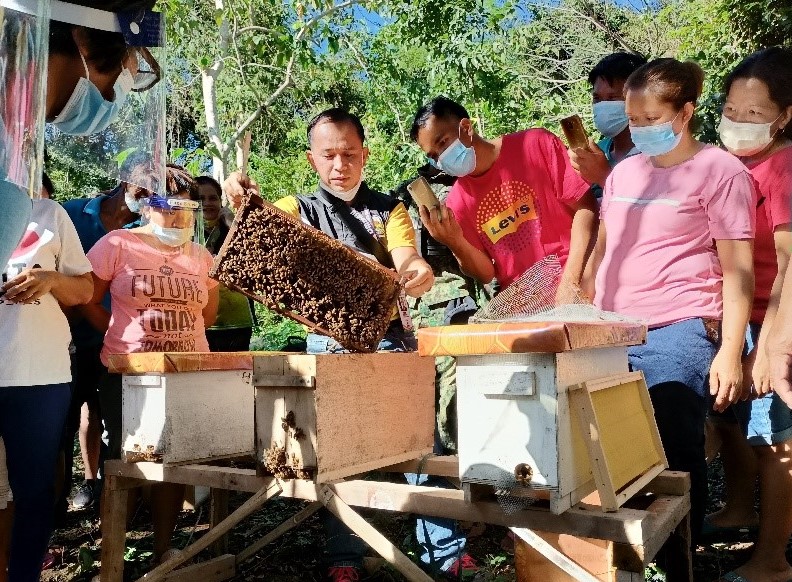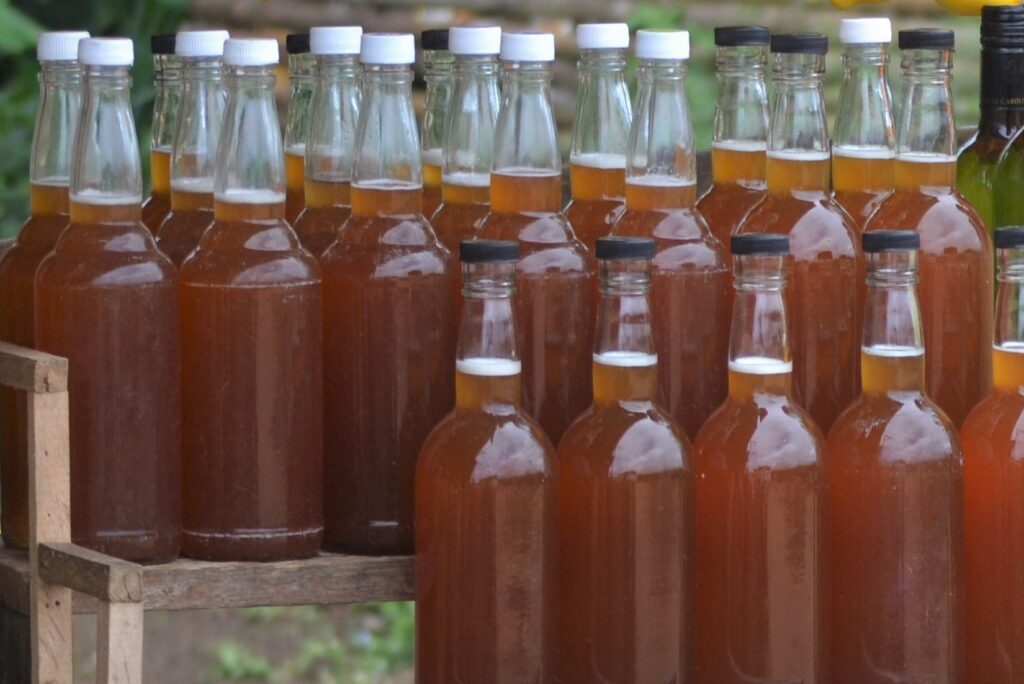Text and Photo by Henrylito D. Tacio
Additional Photo: DOST
In order for those communities near the surroundings around Mount Hamiguitan to discourage the cutting of trees and doing other illegal forest activities, the Department of Environment and Natural Resources (DENR) has introduced a beekeeping project.
The environment department has tapped the Green Solutions Agricultural Farming Training Center (GSAFTC) to bring beekeeping expertise in the industry teeming with international market potential.
The Mt. Hamiguitan Range Wildlife Sanctuary (MHRWS) looks forward to improved crop production for its honey enterprise in the farms of those barangays located in San Isidro and General Generoso, both in Davao Oriental.
A Memorandum of Agreement (MOA) was signed between MHRWS Protected Area Management Board and GSAFTC to expand collaboration on training, marketing-promotional work, experimental, and technology-demonstration on beekeeping.
The beekeeping livelihood program is a special project called “Beekeeping as Biodiversity-Friendly Community-Based Enterprise in MHRWS” of the DENR as part of forest conservation.
The MHRWS has an elevation of 75-1,637 meters above sea level and provides critical habitat for a range of plant and animal species.
“The property showcases terrestrial and aquatic habitats at different elevations, and includes threatened and endemic flora and fauna species, eight of which are found only at Mount Hamiguitan. These include critically endangered trees, plants and the iconic Philippine eagle and Philippine cockatoo,” said the United Nations Educational, Scientific and Cultural Organization (UNESCO).
All in all, the sanctuary is home to a total of 1,380 species with 341 endemics. “Its high level of endemicity is well exemplified by the proportion of its amphibian (75% endemic) and reptile (84% endemic) species.
In 2014, the MHRWS was inscribed as a UNESCO World Heritage Site, becoming the first in Mindanao and the sixth in the Philippines.
Aside from livelihood activities, beekeeping has several other advantages. It is also known to have the very important “pollinating” function in the ecosystem, enhancing environmental balance. It contributes to rapid generation of forest reserves.
The Philippines even imports honey. In 2020, the country imported $5.05-million worth of honey, becoming the 45th largest importer of honey in the world, according to the Observatory of Economic Complexity (OEC). In the same year, honey was the 778th most imported product in the country.
The Philippines imports honey mainly from the United States ($1.86 million), Germany ($1.33 million), Australia ($816 thousand), Austria ($222 thousand), and the United Kingdom ($157 thousand), OEC reported.
The DENR believes that if Filipino farmers can produce honey, then they may be able to fill the import volume.
The Bureau of Agricultural Research said the annual honey production in the country ranges from 50 to 110 metric tons amounting to P21.8 million. The average annual yield per colony is about 0.022 metric tons.
With a more dependable livelihood and income, residents of the buffer zone of MHRWS can become strong forest guards who will help conserve forests and biodiversity of the protected site.
The people’s organizations that can benefit from the project are the Progressive Organic Farmers and Fisherfolks Towards Ecology Conservation of Talisay (PROFTECT) of San Isidro Oriental and the Sergio Osmena Rattan Association of Serbio Osmena, Governor Generoso.
The beekeeping project, which is financed under DENR’s special project fund supervised by the Foreign Assisted and Special Projects Service (FASPS), has already identified two potential expansion sites in barangay Santo Rosario in San Isidro and barangay Macambol in the City of Mati.
“The project was compelled to transfer the beekeeping activity to the GSAFTC site which serves as the recovery area for the propagation of the bee colonies,” said a report. “This is because an infestation of the small beehive beetles occurred due to the erratic weather. This caused the decline of colonies from 241 to 89.”
Another objective of the project is to come up with local policies on biodiversity friendly enterprise and sustainable honey production. In fact, an ordinance for the preservation, habitat protection, and collection of bee products from the wild has been drafted together with the legislative members from municipal and barangay levels, Davao Oriental State University, Department of Agriculture, Department of Trade and Industry, and municipal tourism offices.
The trade department, together with the Department of Science and Technology, has facilitated a training of beneficiaries on handling and packaging of bee products.
Honey – sweet, thick, supersaturated sugar solution – is a good alternative for cane sugar.
Produced by honeybees from the nectar of flowers, honey is highly nutritive. It is also very good for sweetening cakes, confections, and beverages such as coffee, tea, and lemonade. Honey is highly digestible.
Aside from honey, beekeepers can also collect pollen from honeybees. Pollen is the vegetable equivalent of the semen of animals. As such, it contains a wealth of nutrients of every kind which are needed in order to provide the “building blocks of life” to the ovum that it will fertilize. Bee pollen is special because instinctively and carefully select only the best, purest, and freshest flowers from which to gather it.
Other products from honeybees are propolis, royal jelly, beeswax, and bee venom. Propolis, a sticky material which plugs the holes of the beehive, contains a chemical that can be used as anesthetic. Royal jelly is a creamy liquid produced by the glands of the honeybees.
Beeswax, a product of young honeybee workers, can be used as a waterproofing agent in leather and cotton strings, in making candles, and in hair and skin ointments.
Bee venom has some therapeutic values. It contains elements that have been proven effective in relieving inflammation, resisting rheumatism, treating radiation illness, and in reducing cholesterol.
Beekeeping in the Philippines started in the 1930s. However, honeybees did not catch the attention of many people then as beekeeping was considered unprofitable; the few people that went into it did it as a hobby. Sometimes in the 1970s, beekeeping became a fad and more people became interested.
Today, honeybees are raised for profit in backyards in Cavite, Batangas, Laguna, Quezon, and in the Visayas, and as far as Davao in Mindanao.
“At present, the supply of honey and other bee-based products is far below the demand,” experts claim. “Beekeepers could only provide 25 percent of the demand.” – ###
Photo captions:
1 Raising honeybees is one of the economic activities those people living around the surroundings of Mount Hamiguitan can engage on. (DOST)
2 Fresh wild honey can be sold in areas where they are harvested.


